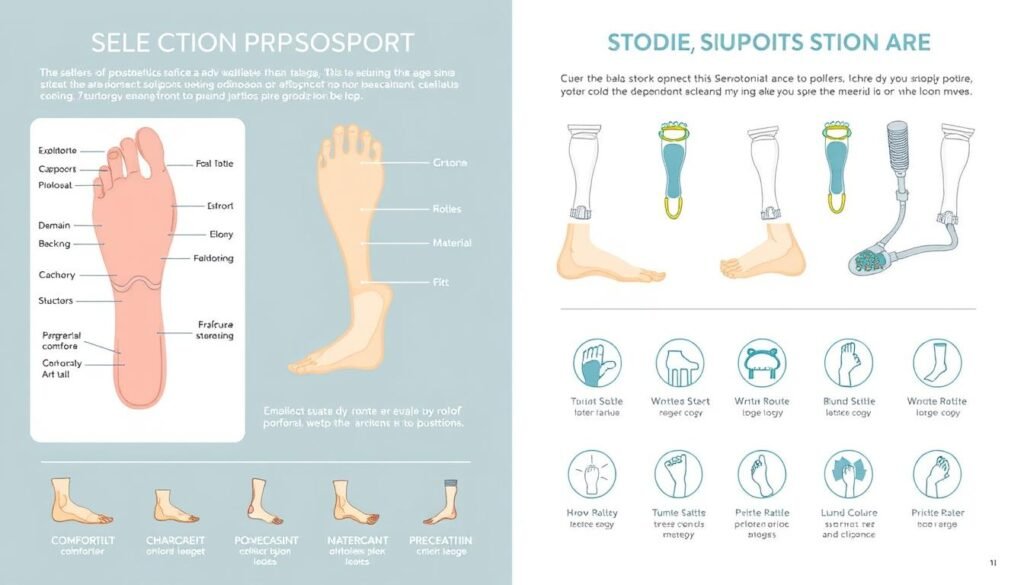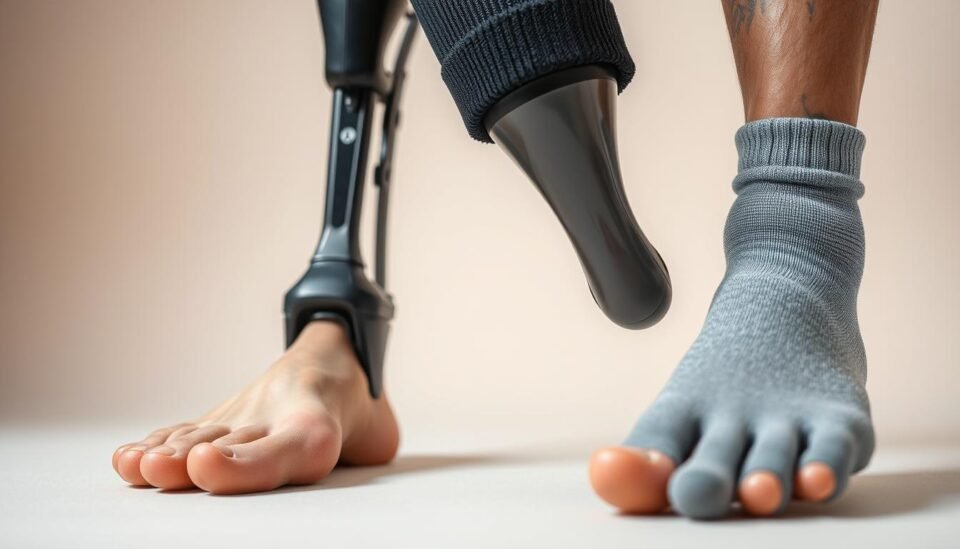Foot pain can make everyday tasks tough. Custom prothotics offer special help for those needing personal foot support.
These devices give targeted relief for many foot problems. They change how people feel comfort and move around.
Professional orthotists are foot support experts. They use special tools to make prothotics that fit perfectly.
These prothotics match each person’s unique foot shape and movement. They’re better than regular insoles you buy in stores.
Custom prothotics spread weight evenly across the foot. They ease pressure and help with conditions like plantar fasciitis.
Athletes and people who stand all day can benefit greatly. These devices can improve foot health for many people.
Custom prothotics are a new way to care for feet. They can make feet more stable and less painful.
With these special devices, people can enjoy life more fully. Investing in custom prothotics can lead to better overall health.
Understanding Prothotics and Their Importance
Prothotics are special medical devices for foot pain relief. They offer support for people with foot problems.
These custom-made solutions help with specific foot issues. They’re different from regular shoe inserts.
Arch support is key in prothotics. They spread body weight evenly across the foot.
Prothotics also reduce stress on certain foot areas. They can fix alignment problems too.
People with plantar fasciitis or flat feet benefit from prothotics. Those with high arches can also find relief.
Over-the-counter inserts differ from custom prothotics. Store-bought ones give little support.
Custom prothotics match your unique foot shape. Doctors use special scans to make them.
Good prothotics can stop future foot issues. They can ease long-term pain.
Athletes often use prothotics to boost performance. People who stand a lot find them helpful too.
The Process of Getting Custom Prothotics
Custom prothotics start with a full foot check-up. Special clinics use top tools to study your foot shape and needs.
A certified expert will look at how you walk. They’ll check your foot shape and any pain you have.
The fitting process uses exact measures and new tech. Pros often use 3D foot scans to map your feet.
This tech helps make orthotics that fit your feet perfectly. It finds pressure points and what your feet need.
After the check-up, skilled workers make a design just for you. They think about arch support and how to spread pressure.
Your lifestyle and foot issues are part of the plan. You’ll have a fitting where the prothotics are adjusted.
Experts will show you how to use them every day. The whole process aims to help your feet feel better.
Working with pros can help you move easier. It can also cut down on foot pain.
Types of Prothotics Available
Prothotics come in three main types. Each type helps with different foot support needs.
Rigid prothotics give the most support. They’re made from hard materials like plastic or carbon fiber.
Athletes and people with bad foot alignment use rigid prothotics. These devices limit foot motion and fix biomechanical issues.
Semi-rigid prothotics balance support and flexibility. They use both soft and firm materials.
People with mild foot problems benefit from semi-rigid prothotics. These help with slight arch collapse or overpronation.
Soft prothotics focus on comfort. They’re made from flexible materials like silicone or foam.
People with diabetes, arthritis, or foot pain use soft prothotics. These provide relief during daily activities.
Each prothotic type has a specific use. Talking to a podiatrist is important.
Podiatrists can help choose the right prothotic for you. They look at your foot shape and activity level.
Factors to Consider When Choosing Prothotics

Your foot shape is key in finding the best prothotic support. Each person’s foot is unique and needs a custom design.
Lifestyle affects prothotic choice too. Athletes need different support than office workers.
Prothotic material impacts comfort and support. Soft materials cushion sensitive feet. Rigid materials give more structure.
Choose materials that match your activity level and foot needs. A foot expert can help you pick the right one.
Foot anatomy and health issues guide prothotic selection. Flat feet and high arches need special support.
A full foot check helps find the best prothotic design. It ensures comfort and good performance.
Don’t let cost affect quality. Good prothotics can prevent future foot problems.
Talk to a foot expert for the best advice. They’ll help you make a smart choice.
How Prothotics Improve Quality of Life
Custom prothotics offer great benefits for people with foot pain. They help spread pressure across the foot, easing discomfort and preventing future issues.
These devices also improve posture by aligning feet properly. This benefits the whole body’s structure.
Athletes love how prothotics boost their performance. They make foot movements better and reduce strain during sports.
People with ongoing foot problems can feel much better with advanced prosthetic solutions. These custom devices help them move more easily and confidently.
Custom prothotics also prevent future foot problems. They give support and fix alignment issues.
This helps keep feet healthy for a long time. It also lowers the risk of serious foot troubles later on.
Maintenance and Care for Prothotics
Daily care keeps your custom foot supports in top shape. Wipe your prothotics with a soft, damp cloth after use.
Avoid harsh chemicals when cleaning your prothotics. Use mild soap and lukewarm water for deeper cleaning.
Let prothotics air dry fully before putting them in shoes. Moisture can harm materials and encourage bacterial growth.
Check your prothotics every 12-18 months for signs of wear. Look for cracks, flattened cushioning, or less support.
Active people may need to replace their prothotics more often. This is due to extra stress on the materials.
See a podiatrist regularly to check your prothotics’ condition. They can tell you when it’s time for new ones.
Store prothotics in a cool, dry place away from sunlight. Keep them away from extreme heat or cold.
These tips will help your custom prothotics last longer. They’ll also keep your feet healthy and supported.
Innovations in Prothotic Technology
Prothotics are changing fast with new tech advances. 3D-printed prothotics are making custom foot support better than ever.
These new devices use special materials. They create exact, personal orthotics that fit each foot perfectly.
Smart orthotics are another big step forward. They have sensors that watch pressure points and how you walk.
Patients can now get instant updates on their foot health. This happens through special tech platforms that study walking patterns.
New materials have helped make better prothotics. Light, strong composites offer more comfort than old materials.
Scientists are working on smart materials too. These can change to fit your feet as you move.
Digital scanning and computer design allow for super custom orthotics. Doctors can now make 3D-printed prothotics that fit each person’s needs.
This new tech makes orthotics work better. It also makes them more comfy for patients.
Testimonials and Success Stories
Sarah Richardson, a marathon runner from Portland, found relief with custom prothotics. Her foot pain vanished, boosting her athletic performance and training intensity.
Michael Torres, a Chicago healthcare worker, overcame plantar fasciitis with personalized orthotics. He returned to his active lifestyle, free from foot discomfort.
Athletes of all levels benefit from precision-engineered prothotics. These support systems tackle individual foot issues and boost overall function.
Custom prothotics are more than just medical devices. They’re tailored solutions that support unique movement patterns.
These orthotics reduce strain and improve physical potential. They work for people with various activity levels.

